Garden Designers Roundtable: Move over, prom queens! Give other plants a chance
Image courtesy of morgueFile
Do certain gardens remind you of high school, where everyone orbits around the popular girls—Rosa (KnockOut), Stella (D’Oro daylily), and Myrtle (crepe)—simultaneously admiring their peppy beauty and begrudging their general domination? I’m not talking about mean girls. After all, Rosa, Stella, and Myrtle are as nice as can be, undemanding and sunny. But when they are always elected prom queen, cast in every school play, and chosen to lead every club, it can get a little oppressive. Don’t let your garden be like high school. Invite some of the less popular kids to join the in-crowd by choosing a few of the following underutilized plants.
‘Sparkler’ sedge (Carex phyllocephala ‘Sparkler’). Do you have a dark, shady corner? Forget about those prom queen impatiens. Instead brighten up the shade with the cream-and-green evergreen stripes of Sparkler sedge. I find it performs best in bright or dappled shade; it will not be happy with long periods of direct sun, particularly afternoon sun. I expected it to be thirstier when I first planted it, but it has proven fairly drought tolerant once established. More good news: deer ignore it. Last winter’s deep freeze turned some of the lower leaves brown, but the plant survived with no protection. The only downside is that it can be difficult to find in nurseries. I’ve seen it locally at both Barton Springs Nursery and the Great Outdoors but not consistently. Your best bet, Austin gardeners, would be to call one of these nurseries and put in a request now for a spring shipment.
‘Black Pearl’ ornamental pepper (Capsicum annuum ‘Black Pearl’). This goth girl is my new favorite annual. Dressed in dramatic black leaves, she doesn’t give a flip about being prom queen. She won’t stop traffic with colorful flowers. But she knows how to create drama with dark foliage that contrasts beautifully with the brighter hued leaves and flowers of her garden companions, and she accessorizes with stunning, black, pearl-like peppers that turn red as they ripen.
Part sun to full sun increases the blackness of Pearl’s leaves; she’ll need a little extra water when it’s really hot to stave off wilting. You’ll find her in early summer at independent nurseries and the big home-improvement stores.
Sotol (Dasylirion). Agaves are deservedly popular here in central Texas, but sotols are the forgotten stepchildren, probably because they are less than impressive in a 1-gallon pot. After a few seasons in the ground, however, sotol grows into a spherical, shimmering focal point, catching the light with hundreds of tiny teeth arrayed on flexible, strappy leaves. Heat, cold, and drought tolerant, it requires only plenty of sunlight and sharp drainage to do its thing. Wheeler’s sotol (Dasylirion wheeleri), pictured above, is my favorite because of its blue coloring. Native to west Texas and the desert southwest, it grows well in Austin with good drainage.
Gorgeous in green, Texas sotol (Dasylirion texanum) is native to central Texas and can be spotted growing wild on rocky escarpments. Both varieties, as well as a few others, are easy to find at independent nurseries like Barton Springs Nursery and the Natural Gardener.
Agastache. I planted a number of agastache in the spring of 2009. Now I wonder how I ever got along without them. These desert-southwest natives need good drainage, lots of sun, and a little elbow room to avoid powdery mildew, but when you find the right spot and give them a couple of seasons to get established, they really put on a show. Agastache has an airy form of tiny leaves on upright stems, just like many of our native xeric plants. It won’t look like much in a one-gallon pot. But after a season or two in the ground it takes off and puts on a colorful show from mid-summer through fall with tubular, hummingbird-attracting flowers. Agastache ‘Desert Sunrise,’ pictured above, is one of the best performers in my garden.
Agastache ‘Acapulco Salmon & Pink’ is also rocking out in combination with cleome, phlox, and ‘Black Pearl’ pepper. The common name “licorice mint” gives a clue that agastache’s leaves are fragrant, which also means deer don’t like it. Check out High Country Gardens online for a good selection. (Full disclosure: Owner David Salman sent me a collection of agastache as the prize for a photo contest back in 2009.)
Snapdragon vine (Maurandella antirrhiniflora). If you want a flowering vine that won’t overwhelm your arbor, much less your house, that loves heat and sun, try this deciduous, dainty climber with ivy-like leaves and purple, snapdragon-like flowers. It dies back in winter but is hardy to 20 degrees F. I cut mine to the ground after a few hard freezes turn it brown. In spring it quickly clambers back up, to around 8 or 10 feet if given adequate sunlight.
Snapdragon vine climbs by twining, so affix a length of thin wire or jute twine where you want it to go. I’ve found it for sale at Natural Gardener and Barton Springs Nursery.
So there you have it—five plants that will shake up the high-school pecking order in many an Austin garden. Keep in mind that these plants are suitable for central Texas growing conditions. If you live elsewhere I can’t speak to their suitability for your climate, but do check out today’s posts from the other participants of Garden Designers Roundtable to see what regional plants they suggest for the topic “Underutilized Plants.”
Andrew Keys : Garden Smackdown : Boston, MA
Carolyn Gail Choi : Sweet Home and Garden Chicago : Chicago, IL
Christina Salwitz : Personal Garden Coach : Renton, WA
Debbie Roberts : A Garden of Possibilities : Stamford, CT
Douglas Owens-Pike : Energyscapes : Minneapolis, MN
Genevieve Schmidt : North Coast Gardening : Arcata, CA
Jocelyn Chilvers : The Art Garden : Denver, CO
Lesley Hegarty & Robert Webber : Hegarty Webber Partnership : Bristol, UK
Pam Penick : Digging : Austin, TX
Rebecca Sweet : Gossip In the Garden : Los Altos, CA
Scott Hokunson : Blue Heron Landscapes : Granby, CT
Susan Cohan : Miss Rumphius’ Rules : Chatham, NJ
Tara Dillard : Vanishing Threshold : Atlanta, GA
All material © 2006-2010 by Pam Penick for Digging. Unauthorized reproduction prohibited.


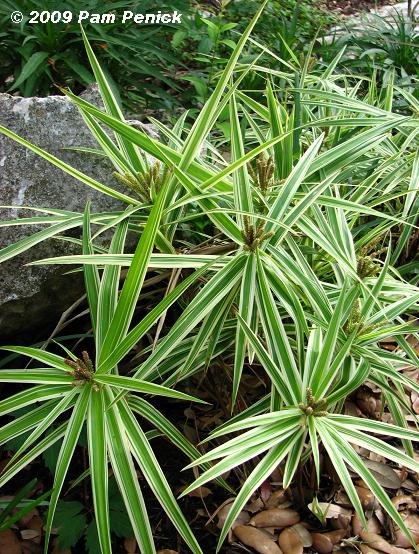
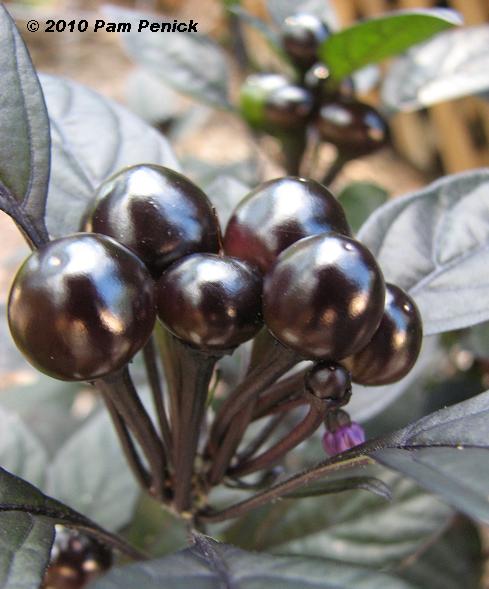
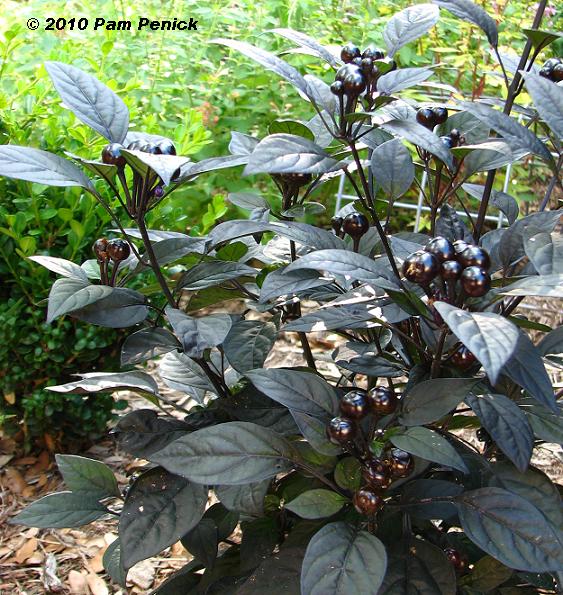
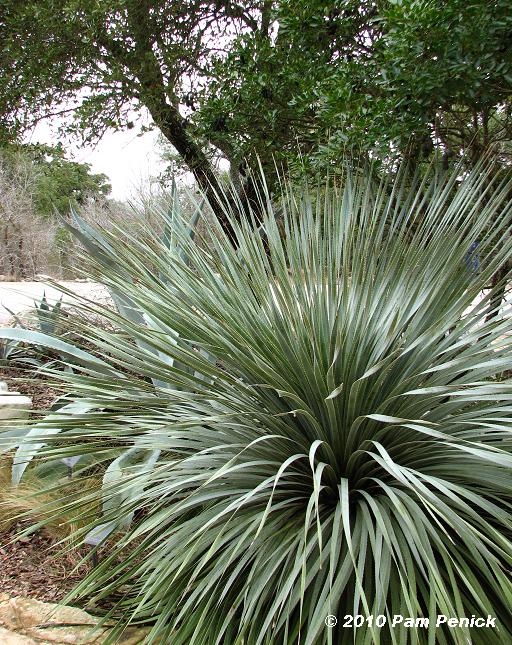
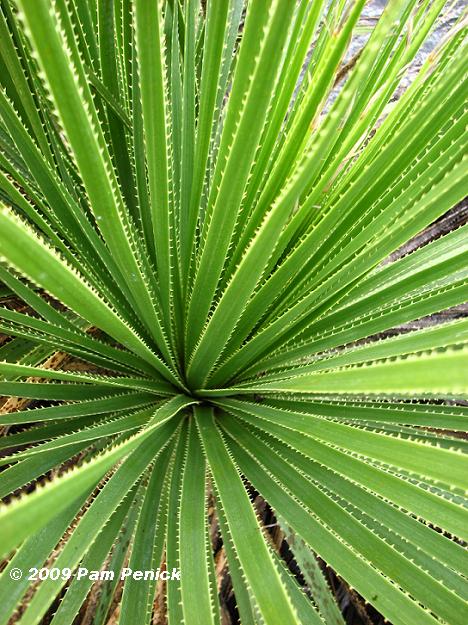
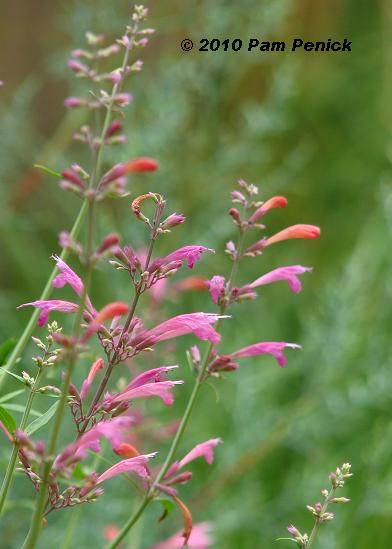
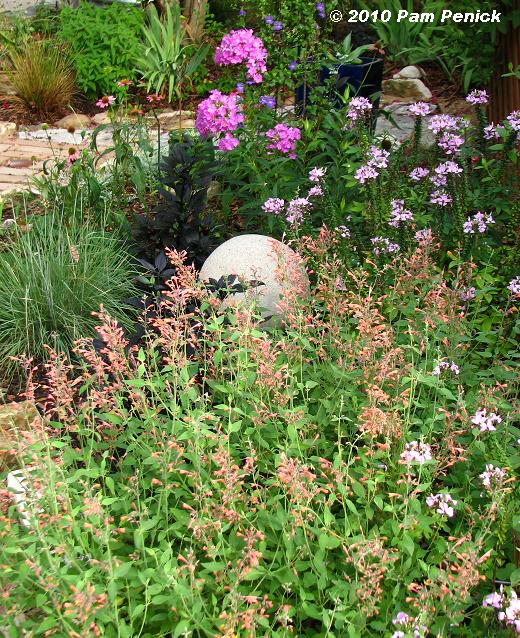
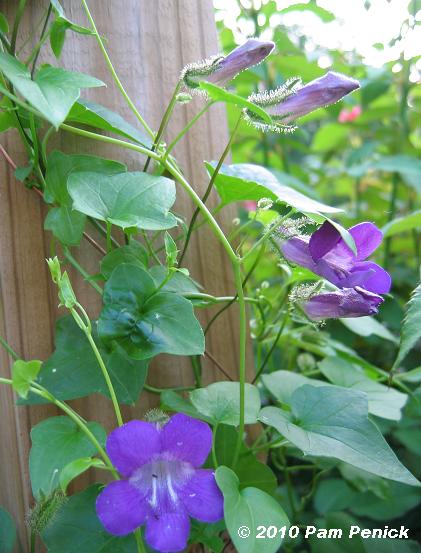
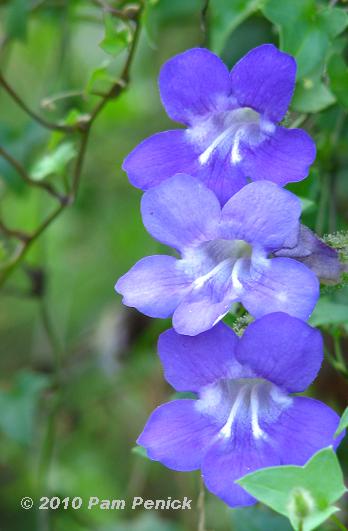
You have some really cool plants. I have a weakness for unusual plants. I discovered Agastache two summers ago. Not knowing what I’d bought (which is often the case), I stuck it in the hot, sunny herb bed, and it was beautiful. Fragile still, I squashed it with the wheelbarrow last summer and killed it. I was so upset, since I still did not know what it was. But the smell…ah, the smell. It was perfect in the herb bed alongside lavender. They both have a great smell together (and alone). I found 2 plants this summer and snatched them up. They have a new home, one not in the path of the wheelbarrow.
Does the ornamental pepper reseed?
Hi, BB. Oh, those mischievous wheelbarrows! Kind of like soccer balls, it sounds like, which have offed a few plants in my gardens over the years. As for the ornamental pepper, I grew it last summer but did not get any volunteers this spring, so it didn’t reseed for me. —Pam
Pam, I love the prom queen spin you’ve given to your post. There really is a lot of drama happening in the garden, isn’t there? Thanks for the introduction to some underutilized plants for the TX garden. I’ve never seen snapdragon vine before, I love the rich purple of the flowers. I’m going to have to look for some seeds so I can grow it next year as an annual in my CT garden.
Debbie, I will save some seeds for you. Just don’t let me forget! —Pam
This reminds me of a customer who came in wanting unusual plants that were different and that none of her neighbors had. This thrilled me as I love to sell unusual plant material to my customers. Boy was I disappointed, she cared nothing about the plants, just worried about apeing her neighbors. She kept leaning towards Indian Hawthorn and Purple Leaf Plum, hardly “groundbreaking”. I tried to steer her in a different direction, but that is what she went home with.
I like your collection of less popular plants. I put an Agastache in last year and it has so far survived our heat and drought. I have it growing up through a ‘Pat Austin’ rose creating a good color combo. ‘Sparkler’ may be deer resistant, but my dogs gnawed it to the ground.
I’m cracking up over the mental image of your dogs gnawing your Sparkler sedge to a nub. Dog-nip, eh? I bet that agastache-rose combo is smashing. —Pam
Pam, the Sotols are amazing and are giving me zonal envy! I have decided to keep a note pad open whenever I visit Digging, as I learn so much when I’m here. Nice selection of “the regular crowd”!
Scott, I am in love with the sotols. There are quite a number to try, and I only wish I had more sunny places in my garden so that I could really go wild with them. —Pam
Pam, Wonderful post~Love the agastaches and have container planted them to give them the conditions they need~Like wise the agaves. The combo of phlox, agastache and cleome speaks to me! Must find that terrific vine! You’ve got me laughing again about the prom queen and remembering my 20 yr reunion~ many late blooming girls found their niche once they escaped the pecking order of hs! gail
Gail, I hadn’t thought about growing agastache in a container to give them the sharp drainage they need, but that’s a great idea. Since they are so drought-tolerant, they’d be fairly easy to keep alive in a pot. —Pam
Love agastache! My Salmon&Pink are keeping up the garden color in the triple-digit heat this summer. I couldn’t have a garden that bakes in 12 hours of summer sun and resists deer without it!
Salvia greggii is rocking right now, too– especially ‘Dark Dancer’ and ‘Diane’.
I am ready to rip-out my KO roses. The Japanese Beetles do a number on them every June and they look ratty until September. However, they bloom so much on either side of the JB damage. I don’t use chemicals and in the heat, I couldn’t do the morning pick and squish routine on 8 rose bushes.
We don’t have the Japanese beetles here in Austin yet, Cameron, so the Knock Out roses are so far unmolested. They are overused but I still love them anyway and have a few in my garden. They really don’t get enough sun to do well though, and I should replace them with something more shade tolerant.
I really need to try ‘Dark Dancer’ and ‘Diane’ salvia. —Pam
Cute post! I can’t say I grow any of those plants, though I probably would if I lived in Texas. I like Pearl’s black leaves. I will confess. I do grow the popular girls you mention. I like unusual too, though. When I first moved here, I refused to plant the “popular” neighborhood stuff, because I didn’t want to look like everyone else. Within a couple of years, though, I discovered that those are growing because they are so super, super tough and evergreen. Since then, many a pygmy date palm, knockout rose, and bottlebrush have found their way into my garden. I still refuse to plant liriope, though. But I might someday. Here’s to all the unpopular girls!
Oh, I’ve planted my share of crepe myrtles, Knock Out roses, and even liriope, Floridagirl. In fact, I think those plants are deservedly popular. They are easy to grow and can stand up to our difficult gardening conditions. But every garden has room for some variety, and it’s wonderful to give some less-used plants some play time. —Pam
Uh oh, looks like the new girls in town are just about to shake up the prom! Entertaining and informative today!
Glad you enjoyed it, Darla. —Pam
Your garden looks lovely, as usual. I think it’s the real prom queen. And, a ‘nice girl’, at that.
It’s always good to learn about plants that can withstand heat AND deer.
Thanks, Linda. Yes, plants that can withstand those challenges and still look beautiful are reason to celebrate, aren’t they? —Pam
Looks like I will be hunting down that Black Pearl Pepper next year! Thanks Pam!
It would look great in your garden, Loree. You need this goth girl! —Pam
Ooooh, the black pearl ornamental pepper is elegant and stunning! The fruits almost don’t look real!
I know, they are remarkably big and shiny, even when they turn red. I love this plant. —Pam
The sotol & agastache would turn up their perfectly-shaped noses at my soil and since you say the sedge can’t take afternoon sun it won’t work either, but I’ve already copied the ‘Black Pearl’ peppers, Pam! The Maurandella antirrhiniflora is spectacular growing on a trellis in the NG parking lot but guess my timing’s been off- never found it for sale in the nursery. Yet. Some day….
Annie at the Transplantable Rose
Gail says she grows her agaves and agastache in containers to give them the good drainage they require; maybe you could do the same for sotol and agastache, Annie. Or you could make a small berm of soil mixed with decomposed granite and plant them there. That worked for me in my former garden, which was on deep clay. —Pam
Love your human-flower angle on this one, Pam!
Sotol is really striking. I have one here and have given one as a gift, too. But yow, are they prickly. Not sure that the damage it’s done to my hands and forearms is worth its loveliness. How the heck do you weed below yours?
I find them less threatening than most of my agaves, Julie, which menace one’s eyes with their terminal spikes. I haven’t had a big problem with weeds under my sotols so far, but I would counsel wearing an old shirt with long sleeves and good gardening gloves. If they are infested with Bermuda grass, or something that weedy, I would probably dig them up, separate them from the weeds, even bare-rooting them if necessary, definitively remove the weeds, and then replant. So long as it wasn’t done in winter, the sotol would probably be fine. —Pam
If ONLY some of YOUR underused plants were hardy here! Oh, sure, I could grow them as annuals in containers (those that aren’t meant to be annuals as it is), but that just isn’t my thing. Oh, well. Those are the pearliest photos of ‘Black Pearl’ pepper I’ve ever seen. Love that plant, even as an annual!
Annuals in containers aren’t my thing either, Andrew—too thirsty. But I will grow a few in the ground. I understand zone jealousy, but believe me, it runs both ways. I just came back from Buffalo, NY, and wish I could grow any number of plants I saw up there that would simply melt or crisp in Austin. —Pam
If this heat wave we’ve had this summer continues we can certainly entertain having some of those gorgeous plants on your underutilized list, Pam. BTW, put me on your GDRT list if you will, my post is up as well.
You’re up, Carolyn! Hope you get some relief from the heat wave soon. —Pam
Very fun read today, Pam (as usual!). Absolutely will try the Black Pearl pepper as an annual next year. Thanks!
It’s a marvelous plant, Jocelyn. I hope it performs well for you in Colorado too. —Pam
Hahaha, your post totally made me smile. There are definitely the prom queens of the garden. I throw Peony in that mix too. I love the ornamental pepper, its so pretty!
I’d gladly grow prom-queen peony if I could, but it would simply melt here. We have our own prom queens, of course, and I’ve got nothing against them, but it’s fun to try something different, isn’t it? —Pam
When my father died in late March, a friend gave me a combo planter of annuals that included Black Pearl. Since it was a gift with no plant labels attached, I wasn’t sure what it was. But it still looks great in that planter on my deck. I’ll look for it next summer. Phlox has done really well in my garden and I hope to add more.
How nice to receive a living gift in memory of your father. ‘Black Pearl’ certainly seems to hold its own through our long, hot summers. I’m glad she’s doing well for you too. —Pam
Good advice! I’m on the outskirts of Houston and the Black Pearl Pepper did reseed for me — 2 years in a row now, even though it was terribly cost last winter.
I would add some of the beautiful alternantheras, even though they’re annuals. Very dramatic! And we need to retire some of our Encore Azalea prom queens too!
Azaleas are definitely prom queens of the southeast! They aren’t as common here because of our alkaline soil. I’m glad you’ve found some good alternatives to the flora in-crowd. —Pam
Wow Pam! There are some truly stunning plants in your selection. I have never seen anything quite like those amazing ‘Black Pearl’ peppers. I don’t know if I can get hold of them in England, but I am certainly going to look around for them. A very inspiring post, thank you. Lesley
Hi, Lesley. I’m surprised the ‘Black Pearl’ pepper isn’t better known since it was chosen as an All-America Selections Flower Award winner for 2006. I hope you can find it in England. —Pam
Well, jealous or what. One or two of these I have not seen for some years and grown only under cover. You make a very valid point about gardens needing different roles performed by plants. Little is more unsettling than a garden full of stars. And it is also valid comment that if things don’t inspire in the nursery in the pots they will not get bought. I guess it is then down to the selling techniques and trust!
Lovely selection.
best Wishes
Robert
And if plants don’t inspire in pots (because they need a season or two of growth to really shine), then nurseries need to showcase them in display gardens with prominent labels. Nothing sells a plant like seeing a mature specimen in full bloom or leaf. —Pam
It’s so interesting to read everyone’s choices from different regions. I find myself wondering how you transplant a Sotol without harming yourself or it. Even I lust over that ‘Black Pearl’ and we know it takes a lot to give me plant lust!
Sotols aren’t hard to transplant because the leaves aren’t stiff. Although they are well-armed with sharp teeth, they are flexible, so a thick long-sleeved shirt and gloves will do the trick. The real trouble is with stiff-spined agaves, and I’ve posted about my experience moving a big ‘Whale’s Tongue’ agave. Whew! I’m glad I survived! —Pam
I have a client who has 2 Sotols in her garden which are absolutely stunning (I wasn’t the one who planted them), and ever since seeing them they’re one of my favorites. You and I have so many favorite plants in common – I’d love to see your garden! And I must find that snapdragon vine! It’s truly beautiful and I don’t think I’ve ever seen one!
The garden is a work in progress, still very much a toddler at just 1-1/2 years old, but I’d be honored to give you a tour anytime you come to Austin, Rebecca. I’ll save you some seeds from the snapdragon vine. —Pam
I tried the sotol but it died this rainy year. I had it in a raised bed with lots of decomposed granite sand. I guess my yard is just too shady or this year was just too rainy. I like it, though, and will have to try it again.
The sotol will take a little shade, I’ve found, but not enough sun coupled with insufficient drainage may indeed have overwhelmed it. I hope you can find the right spot for one. It is so gorgeous at maturity. —Pam
Great post! Love those peppers, and the photos make everything look totally irresistible.
Thanks, TM. I’m glad you enjoyed it. —Pam
Wow – there are some great plants here. Those peppers are awesome and I really like the snapdragon vine. Great post, thanks!
My pleasure, Jayne. The peppers should be easy to find nationwide as they are an All America Selections Flower Award winner. The snapdragon vine is a southwest U.S./Mexico native that is not readily available even in Austin. —Pam
Every time you show your local sotols I really admire their structure–somewhere between the loose and grassy look and the more rigid and agave-ey side. The similar nolinas have been high on my of plants to find a space for in my garden, and we have a local yucca relative that would have a place here if it weren’t for its vicious spiney leaf tips. Thanks for showing the less glam but–as far as I’m concerned–more interesting possibilities we have in our gardens.
I like nolina too, James, and am growing two species in my garden. Like nolina, sotol has the advantage, from a gardener’s point of view, of flexible leaves, making it not quite as “poke-y” as an agave. The toothy leaves can still grab you, of course. I find a little danger makes things exciting though. 😉 —Pam
Pam, great analogy. I like that many of *your* underused plants are *our* natives here in central NM, and a few get used commonly. Just not enough, nor with effective design. Meanwhile, our prom queens are not exactly pretty away from their preferred homes, since the desert is such a radical departure from that.
I think we need to seriously raise awareness of tougher, yet more attractive plant alternatives, by aiming them at the pop culture, which will take away the glory from the plant primadonnas, via continued use of online media.
Thanks for doing your part!
Austin’s independent nurseries are certainly doing their part too, by stocking many species of native plants and growing them in display gardens to show them off. Now if only more people would shop there instead of at the big-box stores, where you generally see the same old plants or new, untested plants that may not be suited to our climate. —Pam
Ooh, love all those plants but especially the Wheeler’s sotol. Such a beautiful blue color. This is the second year I’ve grown Black Pearl. I’m happy with it but it does need a little extra water, as you said. I like the size of that snapdragon vine. I’ll have to see if I can find it next year. Thanks for the good info!
My pleasure, Jean. Are you growing a sotol in your garden yet? —Pam
Nice Pam. I’ve never seen a Black Pearl or a Snapdragon vine. I’ll think I really would enjoy the vine. The color is very soothing. I love blue in the garden.
It’s really more purple than blue, Jackie. The picture didn’t capture the color exactly right. But it is a sweet vine and lovely in bloom. —Pam
Sparkler sedge and Desert Sunrise agastashe are going on my list. I bet the agastashe attracts hummingbirds too.
Yes, the hummingbirds are mad for agastache! And I hear the deer hate it–even better. —Pam
Great pics as usual Pam! You are the queen of making me drool over plant photos.
I just bought my first ‘Black Pearl’ for this year and it’s getting planted today! They generally disintegrate here upon the first rains of fall, but for late summer up until about Halloween, they’re awesome!
Hi, Christina. Yes, ‘Black Pearl’ is perfect for Halloween with those purple-black leaves. I don’t plant a lot of annuals, but that’s one I’m going to keep using. —Pam
I’m afraid I wasn’t around for prom queen but I can see what you mean about those plants. I grew agastache from seed one year but it failed to come back. Maybe the variety was wrong for Texas. Does the snapdragon vine get stronger each year because I put a 4″ in this year and it is so fragile i’m afraid it may just disappear one day. ours looks very robust and much stronger in color. Are there hybrids of this vine I wonder.
I haven’t tried growing agastache from seed so don’t know what might have gone wrong. Seems like you’d have good conditions for growing it with your good drainage and non-clayey soil. The snapdragon vine is strongest in full sun. I used to grow it up the dovecote that now resides in your garden, and it thrived in the hot, sunny front garden (its roots were shaded by other plants). Now I’m growing it in part-sun, and it takes it much longer to get going. I don’t know if there are hybrids. —Pam
Oh Pam! You’ve struck a nerve – or a chord – maybe it’s a chordy nerve! Yes, prom queens – move OVER! You showed some lovely plants that I die over, but imagine my ASTONISHMENT at seeing myself actually DEPICTED as a plant! Yes, I put it forward right now – if I were a plant, I would be the Black Pearl Pepper! That was me in highschool, Goth and underutilized! (ahem)
Seriously, why haven’t I seen this plant before and why isn’t it ALL OVER my garden? I am now going to utilize the HELL out of that plant!
What a great post, AS USUAL!!! – LOVE!!!
XOXOXOIvette
Ivette, I can totally see you as this gorgeous, dark-clad goth girl! You must have a few of these in your garden, where they’d probably live year-round (unless you get one of your rare freezes). Hey, good luck with the photo shoot of your garden tomorrow! —Pam
That is hilarious. I love the prom queen pic at the top and reading about “Pearl” and the rest. My favorite is the sparkler sedge. I know I can grow that here – so stoked!!
You’ll love that sedge, Genevieve. It’s so pretty, brightening up the shade. —Pam
The Black Pearl Pepper is amazing! We’re always attracted to the unusual plants. Sometimes that gets us into trouble by trying to grow things that really would rather not grow in our area. Have you been able to propagate this pepper by cuttings?….how about seeds?
I haven’t tried, Dave. Maybe another reader will know. —Pam
So I love how I’m looking up the snapdragon vine you mention in your reply to my comment on the clematis post, and Google offers up it’s grid of images, and I go “OOO! It’s BLUE” and click only to find myself back on your pages. Fun!
Full circle! Snapdragon vine is more purple than blue, but it’s a sweet, rather dainty climber that’s well-suited to arid gardens. Scott Calhoun grows it in his Arizona desert garden. —Pam